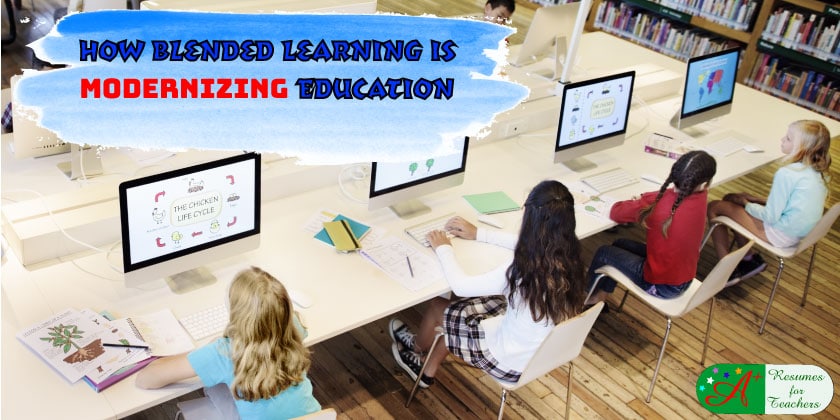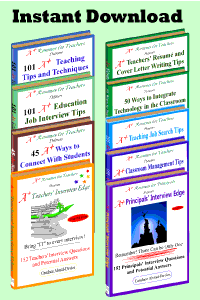Now, the world revolves around the internet. Blended learning is trending and critical to the educational sector.
Let’s discuss how it can benefit the education system and how it has helped modernize education.
Gone are the days where students have to handwrite papers, use slow and clunky typewriters for their assignments, or spend day after day at the library for each class and assignment that arose.
Imagine being able to find the quotation you are looking for with just a click of a button instead of having to search endlessly through volumes in the library.
Better yet, imagine making a mistake on your essay – you can hit “backspace” on the keyboard and continue with the assignment instead of fighting with a typewriter or starting all over again. These exemplify modern learning.
However, there is another angle in which we can look at modern learning, blended learning. Blended learning is an education program where a portion of student learning is facilitated by digital and online media and is controlled by the student to some degree. This program is changing the way we help students learn and create a better future for them. But, to see its potential, we have to understand what it is and how it works.
Blended learning combines traditional education systems (learning in a classroom) with technology-based ones, thus creating a blended program that focuses on moving with individual students and providing them with the assistance they need to succeed.
This school system accommodates each student’s goals, needs, and learning styles, while everyone is still in the same classroom. Blended learning is an excellent concept for providing quality education and differentiated instruction during the allotted class time.
Blended learning is changing the way we help students learn. #blendedlearning Share on XThroughout the school day, each classroom gets a certain amount of time to use computers for educational purposes. When that time comes, each student has a separate account with his/her progress and profile saved.
When students connect to the tablet/computer and use their account, they can access all of their personal data. This example is the core of how blending working works. The computers/tablets enable students to work at their own pace on the lesson’s parts they require help. You could say it’s similar to having a separate tutoring session each day, using methods students enjoy.
You can even use technology to take your students on a virtual field trip.
It allows the student to get the most out of the program, which directly corresponds to having a better understanding of the lesson and a higher intelligence level overall.
Instead of falling behind on classwork, students will be able to work through the difficult concepts at their own pace and understand them much better than they ever had before. In turn, this means a greater motivation to learn, higher test scores, boosted self-confidence, and a continued desire to succeed in the classroom.
In many middle schools around the country, this blended learning system has been very beneficial in English and Math—two skills at the core of education systems. Testing scores have gone up, and students are much better prepared for high school and post-secondary education as a result.
Another potential function of blended learning is adding programs for high school students. If students want to take an AP class not offered at their school, they can liaise with other schools that offer blended learning and learn that way. Many fantastic options with blended learning in high school help prepare students for a college education.
However, blended learning is just at its beginning. Middle schools nationwide are benefiting from the program, and it is slowly being introduced to high school curricula to see how it can best benefit the students there.
The results are already being seen on smaller levels in middle school students learning better, faster, and more enthusiastically. By bringing in computers and tablets to help them with concepts they struggle with individually, students cultivate a greater thirst for learning. This is all due to the idea that students get to use technology in school that they are both familiar with and love to use. The connection between school and technology is crucial moving forward in the world of education – this is the base concept of blended learning.
It is pointless to continue to use the concepts that helped students learn 50 years ago if they are not working on today’s generation. Blended learning brings out the modern technological world while keeping the morals and rigidity of the traditional methods that have served well over the years.
The trick is to keep all the external parts of learning the same but modernize how the education is delivered so students truly benefit from what is being taught and become inspired to pursue life-long learning. If we want students to be smart future leaders, we must ensure learning is exciting and engaging without removing its educational component.
Blended learning combines education and technology to get kids excited about learning and ensuring a bright future.
Therefore, we must zoom back to see how blended learning is changing education to help it move into the modern day. We can look at the easy answer, which is the added touches of technology that get the kid’s attention, but the real answer goes deeper. Because they control it, blended learning helps youth in today’s day and age have an education system that works for them.
Computer programs allow students to move at their own pace, so they get more out of the education system as a whole. If a student struggles with Algebra, he can use the daily time to work at it until he finally understands it; thus, he will have better scores in Math class and be a happier child.
Putting students in charge of their learning is an excellent idea with impressive results.
Blended learning allows that to exist in a way that works for the student. The student will still be learning the right educational topics programmed into the computer. Giving students control will enable them to get more out of the program that we are creating. Since it’s their future, they deserve to have a say in how they prepare for it.
Training in blended learning on a professional level is now a major “must-have” in teacher-training schools. Many programs are starting to implement it into their education systems, so today’s teachers can go right into the classroom educated on blended learning and ready to use it when the time comes.
Experienced teachers continue to take courses in blended learning to provide their students with a valuable learning experience. It is a tremendous asset to include these skills in your resume. Within ten years, blended learning could be in every school, and all teachers would be trained in how to use it to optimize student success.
Those who are applying for jobs in the area must include the keyword “blended learning” on their cover letter and resume and discuss it in an interview. This allows the interviewer to know that you understand blended learning and appreciate its benefits for each student.
Some school boards are interested in looking at applicants with that keyword in their resume. Including this skill will communicate to the hiring representative that you know how important blended learning is to today’s education systems.
Blended learning is a hot topic in educational research right now, and given the trend that is developing, it will be here to stay. Since today’s children’s future depends almost entirely on their formal education system, we must keep working to ensure it is the absolute best for everyone involved.
The research and test scores suggest that blended learning is the way to a better future for school-aged children today and in the future. Now, all we have to do is find a way to incorporate it into every school system in the developed world.


